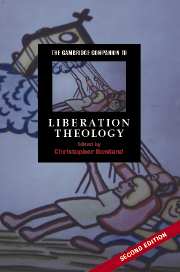Book contents
- Frontmatter
- Introduction: the theology of liberation
- Part I Contemporary Liberation Theology
- Part II Aspects of Liberation Theology
- 7 The origins and character of the base ecclesial community: a Brazilian perspective
- 8 The Bible and the poor: a new way of doing theology
- 9 Liberation and reconstruction: the unfinished agenda
- Part III Analysis and Criticism
- Epilogue: the future of liberation theology
- Select bibliography
- Index
- Series list
7 - The origins and character of the base ecclesial community: a Brazilianperspective
from Part II - Aspects of Liberation Theology
Published online by Cambridge University Press: 28 January 2008
- Frontmatter
- Introduction: the theology of liberation
- Part I Contemporary Liberation Theology
- Part II Aspects of Liberation Theology
- 7 The origins and character of the base ecclesial community: a Brazilian perspective
- 8 The Bible and the poor: a new way of doing theology
- 9 Liberation and reconstruction: the unfinished agenda
- Part III Analysis and Criticism
- Epilogue: the future of liberation theology
- Select bibliography
- Index
- Series list
Summary
Introduction
It seems that for every commentator who has put pen to paper or given voice uponthe lecture circuit, there is set forth a different, and supposedly conclusive,definition of the base ecclesial community (comunidade eclesial de base). Ever since the emergence of this innovative and challengingecclesial phenomenon within the Latin American continent, ecclesiologists andsociologists alike have fallen over themselves in an attempt to explicate theconcrete, lived experiences of those within the base communities by way of theirown preferred analytical vocabulary. The precision with which etymologicalorigins, epistemological status and theological significance is sought, whilstlaudable in terms of theoretical rigour, often belies the haphazard, disjointedand sporadic nature of much of the actual pastoral practice and tangibleexperience of those engaged in the day-to-day struggle to survive at the base ofLatin American society.
As the above intimates, it is not our intention here to understand the baseecclesial community by means of dissecting the words comunidade, eclesial, de base. Rather, we shall explorethe character of the comunidade eclesial de base (hereafter, CEB)by way of highlighting a number of landmark events and experiences which, over thecourse of at least a decade, played a constitutive part in the emergence of theCEB phenomenon. To this end, we seek to understand the CEB, not as a neatlydefinable entity, but rather as an ecclesial tool and lived experience which hasemerged out of a prolonged series of pastoral crises, perceived threats,ecclesiological shifts, theological refinements, and historical exigencies born ofa whole gamut of economic, political, social, and theoretical upheavals. In short,there can be no unilineal representation of CEB development, nor can there begiven a singularly conclusive definition.
- Type
- Chapter
- Information
- The Cambridge Companion to Liberation Theology , pp. 139 - 158Publisher: Cambridge University PressPrint publication year: 2007
- 1
- Cited by



